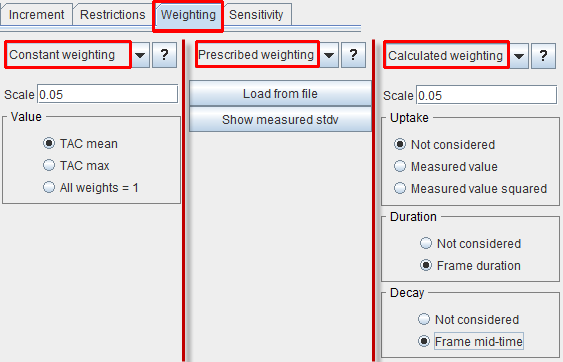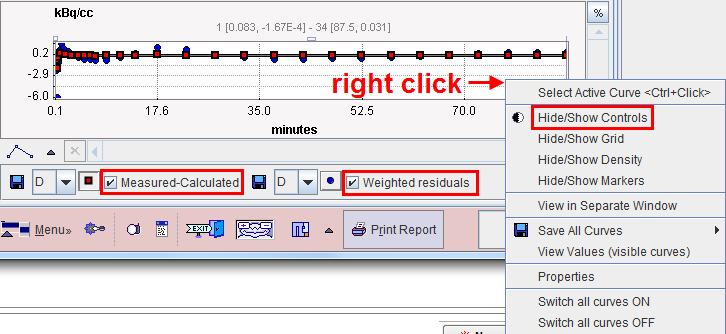Residual Weighting in PKIN
In PKIN, several different weight definitions are supported. They can be specified on the Weighting pane using the list selection with the three entries Constant weighting, Prescribed weighting and Calculated weighting. The contents of the different selections are illustrated in parallel below.

Constant |
With constant weighting the same weight is applied to all residuals. Its size can be adjusted by the Scale factor and the radio button setting. In the case of TAC mean si is obtained as the average of all values in the TAC multiplied by the Scale factor. Similarly, with TAC max si is obtained as the maximal TAC value multiplied by the Scale value. With All weights = 1 the weights are all set equal to 1 independent of the Scale (si = si2 = wi = 1). |
Prescribed |
The default behavior of this method is to use the standard deviation of the pixel values in the VOI for calculating the TAC for weighting. This information is automatically available if the TACs have been sent from the PMOD viewing tool to PKIN, and can be visualized using the button Show measured stdv as illustrated below. |
Calculated |
With this selection the variance is calculated for each TAC value from an equation which may take into account the measured uptake, the correction of the radioactive decay, and the duration of the acquisition. The full equation is as follows:
|
Each time the configuration is changed, the standard deviation si is calculated and plotted as an error bar around the measurements. This feedback gives the user a visual feedback as a help in judging the adequacy of the specified weighting.

Loading Externally Defined Weights
Some users might want to implement their own residual weighting schemes. To this end they should calculate the standard deviations si for the different acquisition frames from which the weights will be calculated according to
![]()
The si should be prepared in a tab-delimited text file of the following form:
t[seconds] |
|
standard-dev[kBq/cc] |
10 |
|
0.10300076 |
30 |
|
0.01717448 |
50 |
|
0.01195735 |
70 |
|
0.01010257 |
etc |
|
... |
The header line is required. The first column represents the frame mid-times (although the values are not interpreted), and the second column the standard deviations in appropriate units. The number of entries must be equal the number of acquisitions, and the columns separated by spaces or tabs. For example, such a file can be prepared in MS Excel and then saved as a text file with tab delineation.
This definition can be loaded by the Load stdv from file button available with Prescribed weighting.
Display of the Residuals
The curve area with the residuals contains the information of the raw unweighted as well as the weighted residuals. The context menu as illustrated below (right mouse click into the curve area) can be employed for showing/hiding the curve controls and using them for changing the displayed information.

Use of the Weights in Monte Carlo Simulations
Monte Carlo simulations require the generation of noise which is defined by a distribution type as well as its deviation characteristics. Assuming that the weights specification corresponds to the standard deviation of the measurement noise, the regional weighting specification is used in the Monte Carlo noise generation together with the distribution type. Note that the Scale factor has no impact on fitting, but that it is highly relevant in Monte Carlo simulations.